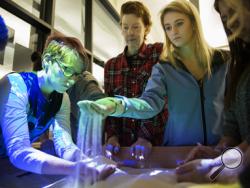GOODING, Idaho (AP) — This isn't your childhood sandbox.
You don't sit in it and make sandcastles. Instead, you load a topographic map on a computer and project a 3D image onto the sand. After sculpting it with your hands, you can feel geological features such as mountains and canyons.
In early December, the Idaho School for the Deaf and the Blind in Gooding purchased an augmented reality sandbox using a $10,000 grant from the America's Farmers Grow Rural Education program, sponsored by the Monsanto Fund.
The $7,000 sandbox — a big box on wheels kept in a corner at the school library — mimics how things work in their natural environment. It allows students to have interactive learning experiences about topics such as land forms, the water cycle and erosion.
"It's more hands-on and makes a lot more sense than a lecture or picture," school librarian Sharlyn White Jackson said.
Students who are blind or visually impaired can feel features such as a plateau or canyon in the sand. Students who are deaf or hard of hearing can see the natural features in the sandbox "and it explains itself," White Jackson said.
Earlier this month, six high school girls — all of whom are either blind or visually impaired — worked with the sand along with science teacher Rose Crews.
They scooped up sand in their hands and let it run through their fingers. Small clouds of dust flew up.
Crews told students she wants to purchase an option for the sandbox to simulate earthquakes. But in terms of experiencing natural features, "I think your hands will be the best tool," she said.
During the lesson, one girl said "let's make a lake." Another responded, "what shape?"
Conversations frequently started with a phrase like "let me try," followed by students experimenting with shaping different geological features in the sand.
It was the first time 15-year-old Maizy Wilcox had used the sandbox. She said it helps her understand how mountains develop, as well as differences in elevation.
"I think it's really neat," she said. "I've never learned anything like it."
The sandbox uses a Kinect 3D camera, like the ones used for Xbox game consoles. The school uses free, open source software to download topographic maps.
Students can see and feel scale models in the sand of the Grand Teton mountains or the Grand Canyon, for example.
It can also simulate water and students can see the color of the sand change to represent changes in elevation.
"It helps these kids go places they've never been," White Jackson said.
For children who are blind or have vision challenges, they may never see the Grand Canyon, she said, but with the augmented reality sandbox, "they can feel it."
One of the first topographic maps White Jackson hopes to use with students is of the Snake River Canyon. "We drive over it all the time," she said.
The sandbox makes abstract concepts easy to see, 18-year-old Taylor Bullock said through an American Sign Language interpreter. That includes how natural features are formed and different climates.
Bullock said she'd love to see a 3D topographic map of Costa Rica because she has heard there are gorgeous mountains there. She'd also like to learn how they developed over time.
The America's Farmers Grow Rural Education program wants to ensure students have the education and skills they need to fill an increasing number of science, technology, engineering and math jobs over the next 10 years, it said in a statement last month.
After local farmers nominate a school for grant funding, the school district must submit an application for a STEM-focused project. A national advisory council chooses the recipients.
At ISDB, school administrators decided to write a grant application for an augmented reality sandbox.
"In the era we're in, we have to be a little more creative in how we do things," White Jackson said.
Last year, the America's Farmers Grow Rural Education program awarded a total of $2.3 million in grants, it said in a statement. And since 2011, it has awarded more than $14 million to about 750 rural schools.
Back in Gooding, 17-year-old ISDB student Emi Ryland said one of the most interesting things she experienced using the sandbox was "the way the water and the land connects."
In the future, she'd like to look at a 3D topographic map of Hawaii. "I'd like to see how volcanoes are made."
Augmented reality sandbox teaches disabled students
Posted: January 21, 2018 - 4:00am

